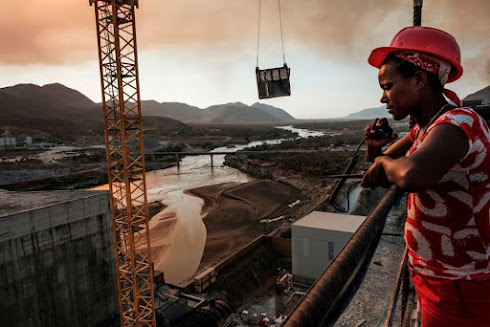Water Wars I: The Darfur Conflict

UN Peacekeepers in Darfur, Sudan (Source)
“There are layers and layers of conflict, so we started with what they could agree on, and everyone agrees there is a problem with the environment, with water by far the biggest priority”
- Atila Uras, head of the United Nations Environment Programme (UNEP) in Sudan
Water conflicts are arise as communities experience disruptions over access and distribution of portable water, constraining stakeholders to attempt to obtain or exploit more shared water resources, leading to diplomatic tension and/or violent conflict. As discussed in the introductory blog post, the Nile Basin is seen by many political commentators as the breeding ground for a contemporary water conflict, where Ethiopia's building of the GERD is seen as a threat that can influence the flow of the River Nile's flow, and wield disproportionate economic power by downstream riparians Egypt and Sudan. However, this notion that there is a looming conflict should be approached with caution, in part because an example of a water conflict in the Nile Basin already exists, albeit at a smaller scale, which provides plenty of examples of solutions to avoiding military conflict.
The Darfur, Sudan sits in the semi-arid Sahel region in North Africa that acts as the transition zone from the Sahara desert to Southern savannah . The Darfur region has been marred by small-scale since the 1980s, increasing in scope in 2003 to become an official (and still ongoing) conflict as members of the Sudan Liberation Army (SLA) and the Justice and Equality Movement (JEM) waged war on Sudanese government facilities and Arabized indigenous Africans who also comprise the state allied Janjaweed militia. The conflict largely stems from friction between between nomadic pastoralists and static farmers, alongside constant regional political instability.
It began as an ecological crisis, arising at least in part from climate change. Nomadic camel herders, who rely on availability of wells across regional boundaries as they travel, clashed with communities of farmers, new to the region, who congregate around water sources to grow food and graze cattle. While there was clearly a human-made commons access conundrum, for example the Canalisation of river flows in wetlands by cattle farmers, environmental factors, such as encroaching desertification have long led to considerable tension between nomads and more established sedentary farming communities. Both groups have created militias and village self-defence groups. Secure-water collection areas soon became targets in warfare.
"Access to water and markets is increasingly difficult and the profitability of livestock-keeping is being critically undermined." - Dr. Farouk El-Baz, Boston University
While the humanitarian consequences of the conflict have been tragic, communities in Darfur have been forced to improve their water management practices. Cooperation and peace opportunities are increasing, largely by improving and sharing access to water points.
Development practitioners are in agreement that improvements to how much water is available for use will depend primarily on how well this resource is managed. The United Nations Environment Programme’s report 'Sudan: Post-Conflict Environmental Assessment' identifies key environmental solutions require cooperation over water. Successful examples that have deescalated the conflict in El Fasher, Dafur centred around enabling quarrelling communities to come to an agreement on how to share the water and land. All stakeholders agree that there is an environmental problem, particularly focused on water. Of particular success, the Wadi El Ku Project has brought 7 pastoralist groups and 44 farming villages together by using community-built weirs, which has gone a long way to improving institutional and organizational capacities in North Darfur.

Details of the EU and UNEP funded Wadi El Ku Project (Source)
It should be noted this is a very brief description of what is an extremely complex and contentious conflict, so please see the video below for more information. However, as we look at brewing tensions in the Nile Basin, the Dafur conflict is important for reminding ourselves that facilitating cooperation and responsible, multi-stakeholder water management are crucial for reducing conflict. In the next post we will see how these lessons can be applied to the GERD context.
(Source)



This is a really good take on water wars in my opinion. Finding a specific example in the Nile River Basin (Darfur) makes it much easier to realise how cooperation is most of the time prefered to conflict. Do you think this will reflect patterns of conflict within other riparian states as the GERD fills?
ReplyDeleteThank you! I personally don't think there will be a violent conflict as a result of the GERD, however, I think if there is to be conflict from the GERD it will be between states rather than within them, maybe except Sudan, where there is already a fragile civil conflict. I would recommend reading my next post on what a potential conflict (or not) would look like in the case of the three quarrelling riparians.
ReplyDelete